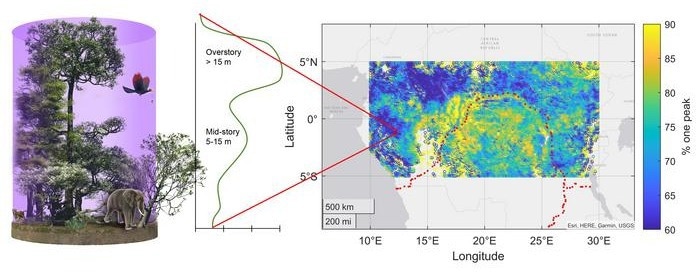The rainforest canopy, where the majority of the world’s species reside, has received less research interest than the surface of Mars or the bottom of the ocean. GEDI, a NASA space laser that provided the first-ever detailed structure of the world’s rainforests, is about to change that.
 Graph depicting canopy information obtained from GEDI. Image Credit: Nicolle Fuller and Chris Doughty.
Graph depicting canopy information obtained from GEDI. Image Credit: Nicolle Fuller and Chris Doughty.
New research published in the journal Environmental Research Ecology details the laser’s findings. The study was co-authored by scientists from the United States, the United Kingdom, and Singapore. Christopher Doughty, Professor in NAU’s School of Informatics, Computing, and Cyber Systems and the study’s first author, believes it is vital—and long overdue—to learn more about tropical ecosystems.
Most of the world’s species live in tropical forests and most of those make use of the canopy, and yet, we know so little. Rainforest structure matters because it controls how animals access resources and escape predators, and these findings will help us understand tropical forest animal’s susceptibility to climate change.
Christopher Doughty, Study First Author and Professor, School of Informatics, Computing, and Cyber Systems, Northern Arizona University
Forest canopy research has come a very long way. Early western visitors defined tropical forests as horror vacui (nature abhorring a vacuum) because of the vegetation “anxious to fill every available space with stems and leaves.” Eventually, as researchers studied tropical forests, they classified the lush flora into forest layers—a thick upper crown, a thick mid-layer, and a thin layer in between. This, however, was only seen in a few well-studied locations. The structure of most tropical forests remained unknown.
The Global Ecosystem Dynamics Investigation (GEDI) then emerged.
A key difference between GEDI and many other satellites is its measurement of three-dimensional canopy structure. Conventional satellites, while providing valuable data on land cover and canopy greenness, often lack the detailed vertical information offered by GEDI. This vertical information is crucial for understanding ecosystem dynamics, carbon storage, and biodiversity that cannot be easily seen from typical satellite images.
Hao Tang, Study Co-Author and Professor, Department of Geography, National University of Singapore
Tang is also a principal investigator at the NUS Centre for Nature-based Climate Solutions.
NASA’s GEDI, launched in late 2018, shoots an indistinct laser into the forests of Earth thousands of times per day from the International Space Station. Based on the amount of energy returned to the satellite, it can create a detailed 3D map of a forest that reveals where the leaves and branches are and how they change with time.
This will assist researchers in determining how much biomass and carbon forests store and how much they lose when disturbed—critical information for understanding the Earth’s carbon cycle and how it is changing.
Doughty, Tang, and co-authors examined GEDI data from all tropical forests and discovered that the structure was relatively simple and more exposed to the sun than initially assumed.
Data also revealed that most tropical forests (80% of the Amazon and 70% of Southeast Asia and the Congo Basin) have a peak in the number of leaves at 15 m rather than at the canopy top, refuting early researchers’ fullest-at-the-top theory.
While forests differ, one key finding that seemed to hold across all scenarios was that deviation from more ideal conditions (such as lower fertility or higher temperatures) did lead to shorter, less stratified forests with lower biomass.
It was really surprising to see the dominance of this structure type because it differs from what we had learned in the classic textbooks on the topic. These finding will not only help us understand how the millions of species that live in a rainforest canopy might acclimate to changing temperatures, but also how much carbon these forests hold and how good they are at fighting climate change.
Christopher Doughty, Study First Author and Professor, School of Informatics, Computing, and Cyber Systems, Northern Arizona University
Journal Reference:
Doughty, C. E., et al. (2023). Tropical forests are mainly unstratified especially in Amazonia and regions with lower fertility or higher temperatures. Environmental Research Ecology. doi.org/10.1088/2752-664x/ace723.